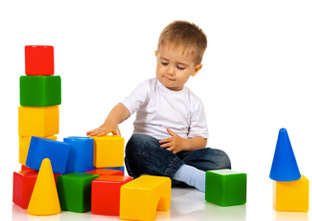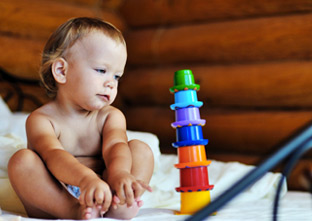Awakening the senses

You mainly work with children. What problems do they encounter ?
These are children who are not fully aware of their bodies. Their actions are disordered; some even have sensory disorders and therefore have difficulty differentiating between materials. Of course, we tailor our therapies according to the degree of the child's disability; some cases are more complex than other. The children we meet sometimes have difficulty with awareness of their surroundings. Regardless, our methods remain essentially the same as we focus our work on play. Children need to be enjoying themselves in order to make progress.

Are these sessions stressful for the children ?
 Quite the contrary! But make no mistake - although we talk of play, it takes place first and foremost in a therapeutic setting. Our activities focus on movement, action, communication and emotions...Our role is to stimulate children and to encourage them to use their five senses. To do this, we strive to place the child in situations that are new to him, for instance by modifying his space and seeing how he reacts. We can also show him objects that are unknown to him. We have many accessories to help us in this task.
Quite the contrary! But make no mistake - although we talk of play, it takes place first and foremost in a therapeutic setting. Our activities focus on movement, action, communication and emotions...Our role is to stimulate children and to encourage them to use their five senses. To do this, we strive to place the child in situations that are new to him, for instance by modifying his space and seeing how he reacts. We can also show him objects that are unknown to him. We have many accessories to help us in this task.
What are they ?
 They are objects that are often very colourful; the colours make them easier to spot and are also useful for generating a response to an "explosion" of colours. We have foam floor mats of varying degrees of thickness and flexibility, plastic-covered foam cubes and tunnels with which we can design courses to be navigated. We also use balls of varying sizes and materials and, of course, play mats with a whole range of various accessories such as rings, rattles, plastic sheets, balls...These objects must be easily palpable and graspable by small hands and must be hygienic above all. We cannot imagine such accessories made from metal as they would be extremely difficult to handle.
They are objects that are often very colourful; the colours make them easier to spot and are also useful for generating a response to an "explosion" of colours. We have foam floor mats of varying degrees of thickness and flexibility, plastic-covered foam cubes and tunnels with which we can design courses to be navigated. We also use balls of varying sizes and materials and, of course, play mats with a whole range of various accessories such as rings, rattles, plastic sheets, balls...These objects must be easily palpable and graspable by small hands and must be hygienic above all. We cannot imagine such accessories made from metal as they would be extremely difficult to handle.
Where do you find these objects ?
We buy them from networks of specialized resellers. There are standards and we cannot afford to buy just any old thing. I'm no expert but I imagine that these objects must pass certain tests in order to be approved. In all cases, they are very durable and easily washable. I believe that this is one of the main reasons for plastics being so widely represented. It may also be a matter of cost. That said, some of these items can be found in toy stores.
![]()
You also work with babies. Do you use the same methods with children who cannot yet walk ?
 Not quite, but the purpose remains the same. And the fact that a baby does not walk does not mean that it is static. After a few months, a child is able to crawl, or even move around on all fours. It is also during this time that doctors are able to detect whether there are any problems with dyspraxia (impairment of the ability to perform specific movements in an automatic way) or apraxia (inability to perform a movement). Whatever the age of the child, our first objective is to make him aware of his body. He must understand how to use his limbs, his hands...He therefore requires constant stimulation, and we achieve that by placing him in new situations. Smaller children do a lot of touching and manipulating, it is the time of discovery! Plastics are essential in this awakening of the senses because the diversity of colours, shapes and textures allow us to provide a truly multi-sensory approach. Some children even go so far as trying to "taste" them... Once again, plastics come in useful as they can so easily be disinfected with no risk to the child.
Not quite, but the purpose remains the same. And the fact that a baby does not walk does not mean that it is static. After a few months, a child is able to crawl, or even move around on all fours. It is also during this time that doctors are able to detect whether there are any problems with dyspraxia (impairment of the ability to perform specific movements in an automatic way) or apraxia (inability to perform a movement). Whatever the age of the child, our first objective is to make him aware of his body. He must understand how to use his limbs, his hands...He therefore requires constant stimulation, and we achieve that by placing him in new situations. Smaller children do a lot of touching and manipulating, it is the time of discovery! Plastics are essential in this awakening of the senses because the diversity of colours, shapes and textures allow us to provide a truly multi-sensory approach. Some children even go so far as trying to "taste" them... Once again, plastics come in useful as they can so easily be disinfected with no risk to the child.
You were telling us about courses. Can you tell us more ?
 Of course. Here, the accessories available to us are once again extremely useful. For instance, when we decide to make a course, we can set up floor mats of varying thickness, ensuring that the child will have to adapt in order to find his balance. As for the walls, they are made from stacked foam cubes. Some of the cubes have bevelled edges, meaning that we are not limited to building on the horizontal plane alone. When the child approaches an incline, he will quickly discover the effects of gravity and will therefore adapt his movements and the distribution of his mass if he wants to avoid falling down.
Of course. Here, the accessories available to us are once again extremely useful. For instance, when we decide to make a course, we can set up floor mats of varying thickness, ensuring that the child will have to adapt in order to find his balance. As for the walls, they are made from stacked foam cubes. Some of the cubes have bevelled edges, meaning that we are not limited to building on the horizontal plane alone. When the child approaches an incline, he will quickly discover the effects of gravity and will therefore adapt his movements and the distribution of his mass if he wants to avoid falling down.
And finally, what purpose do the small and large balls serve ?
The larger balls are often a source of exchanges and therefore of communication. Children understand very quickly that a simple gesture enables them to move this rolling and relatively light object and to send it over to another person (adult or child). The smaller balls are used for essentially the same purpose. Some of them are "lumpy" and others have small protrusions. These help us to assess how the child reacts to a change in material and therefore in feeling...like when he's on a play mat. Plastics have many advantages given that they can take any form, even the most unusual, and are especially light. Children are therefore easily able to manipulate the balls or throw them around.

Can progress be quickly made with all these techniques ?
 As you say, these are only techniques. Helping a child with a psychomotor disorder to make progress also requires communication. This is why play is so important. We ask the parents to continue this work at home. It is very important! As for accessories, some are very useful and many parents have one or the other. I believe that this is another of plastic's advantages - they are ultimately not overly expensive.
As you say, these are only techniques. Helping a child with a psychomotor disorder to make progress also requires communication. This is why play is so important. We ask the parents to continue this work at home. It is very important! As for accessories, some are very useful and many parents have one or the other. I believe that this is another of plastic's advantages - they are ultimately not overly expensive.





